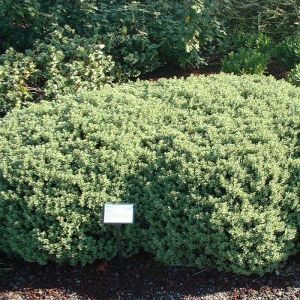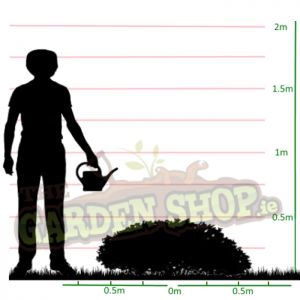| Orders over €75, get |
 free delivery free delivery |
Cart is empty
My account
Information
Garden Equipment & Supplies
© 2004 - 2025 TheGardenShop.ie. All rights reserved.

![]()
Planting Medium Sized Garden Shrubs
When we talk about medium sized shrubs, we mean plants that reach 1 to 1½ metres in height and therefore plants that are suited to small & medium sized gardens. This size range of plants includes a wide selection, many of which offer a lot of colour in both flowers & foliage. Because of their manageable mature size, medium sized shrubs are generally easier to maintain & are perfect in all gardens.
Below is a quick guide on how to plant medium sized shrubs to ensure they get the best start & give maximum results in the garden.
Planning
The planting process can begin at the drawing table where you are best placed to decide & plan the style & type of planting scheme you want. When planning, the easiest thing to do is to divide plants into specific size groups and then choose these groups in the following order.
Medium sized shrubs can be considered the ‘decorative’ shrubs. By this, we mean the plants that create the theme & style to your garden. Your selection of medium sized shrubs can follow specific themes such as flower colour, all white for example.
When designing & planting you should start with large plants because these will form the structure to your flower beds and will determine your decision making on all other plants that follow.
Once large & focal point plants are chosen you can focus on the medium sized plants. These plants should all work with each other in terms of leaf colour, texture & shape and also in terms of the plants overall shape or form. Your selection of plants should combine & contrast well to create an interesting & harmonious scheme.
Once you are happy with the choice and position of your larger plants you can move on to planting & preparing your soil.
Preparing Your Soil
To ensure your plants settle in quickly & start growing as soon as possible, it is important to handle your plants carefully & provide your plants with the best soil & growing conditions.
Firstly, you can dig out a hole for your plant. It is now said that square holes are better than round holes as a square hole ensure better root formation. The size of the planting hole should be about twice the width of the plant’s container & 1½ times its depth. Once you have dug the hole, loosen up the soil in the base of the hole to encourage roots to grow downwards. A plant with a deep root system will perform better during stressful conditions.
If your soil is sandy, stony or very shallow then you will need to dig an even bigger hole & back fill with rich loam topsoil.
Once the hole is dug, add a small amount of john Innes No. 3 compost or add farm yard manure and mix it through the existing soil. At this point you can also add a small amount of fertiliser, for medium plants you can add 35 grams of growmore plant food.
Planting
Handling your plants with care is very important, your plants will already be experiencing the shock of being moved which will lead to a stunt in plant growth. So any additional stress caused to the plants at this point should be avoided.
If your plants are dried out, it is essential that you soak the root ball for 10 minutes before planting. To do this, you can fill a bin or very large bucket with water and push the plant’s rootball & container down into the water. While the plant is soaking, you can prepare the planting hole as mentioned above.
Carefully lift the plant from its pot, gently ‘tickle’ the plants root ball to free up the roots and encourage them to start growing outwards. Next, you need to determine the plants best side, and then position the plant in the hole. Before back filling, ensure the plant is both level vertically & also level with the surrounding ground.
It is very important to not plant a shrub too deep (will lead to stem rot) or too shallow (can lead to poor establishment & root ball drying out). Once you are happy, you can back fill the soil & then press the soil in well with a strong tap of your foot.
Aftercare
The immediate after care of your plant is simply to water it in. Keep an eye on the plant for the first few months & make sure the soil never dries out. In very warm Summers, you will need to water in new plants every 2 to 3 days.
If there are any bamboo canes or supports with the plants these need to be loosened now. Feed your plants every Spring & make mulch in Winter to keep your plant insulated & free from weeds.
For more on designing with plants & caring for you soil see our How To Garden section.
Note: We don't ship plants on Fridays due to the extended period they would remain without light & water
Shipping Options & Rates
FOR IRELAND & NORTHERN IRELAND
MAINLAND ENGLAND & SCOTLAND & WALES (Currently Unavailable Due to Brexit)
WESTERN EUROPE & WORLDWIDE
Bulk Bags & Large Item Pallet Deliveries
International Delivery Prices & Times

Terms
| Orders over €75, get |
 free delivery free delivery |
My account
Information
Garden Equipment & Supplies
© 2004 - 2025 TheGardenShop.ie. All rights reserved.




